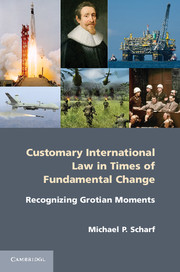Book contents
- Frontmatter
- Contents
- Author’s Biography
- Acknowledgments
- 1 Introduction
- 2 Historical Context
- 3 Theoretical Underpinnings
- 4 Nuremberg
- 5 The Truman Proclamation on the Continental Shelf
- 6 Outer Space Law
- 7 The Yugoslavia Tribunal’s Tadic Decision
- 8 The 1999 NATO Intervention
- 9 The Response to 9/11
- 10 Conclusion
- Index
- References
9 - The Response to 9/11
Published online by Cambridge University Press: 05 June 2013
- Frontmatter
- Contents
- Author’s Biography
- Acknowledgments
- 1 Introduction
- 2 Historical Context
- 3 Theoretical Underpinnings
- 4 Nuremberg
- 5 The Truman Proclamation on the Continental Shelf
- 6 Outer Space Law
- 7 The Yugoslavia Tribunal’s Tadic Decision
- 8 The 1999 NATO Intervention
- 9 The Response to 9/11
- 10 Conclusion
- Index
- References
Summary
This chapter examines whether the systematic al Qaeda terrorist attacks against the World Trade Center and Pentagon on September 11, 2001, and the international community’s political and tactical reactions to those attacks have generated a Grotian Moment, leading to new rules of customary international law concerning use of force against nonstate actors. The International Court of Justice had previously opined in the 1986 Nicaragua case that victim states could not resort to force in response to attacks by nonstate actors unless those actors were effectively controlled by the territorial state. A few days after the September 11 attacks, however, the UN Security Council adopted Resolution 1368, which was widely viewed as confirming the right to use force in self-defense against al Qaeda in Afghanistan, and there was little international protest when the United States invaded Afghanistan shortly thereafter. With the subsequent deployment of unmanned drones to hunt down al Qaeda terrorists in Afghanistan, Pakistan, Yemen, and Somalia, the response to 9/11 is not just about the radical change in the terrorist threat but also in the technology used to combat them. Invoking the term “constitutional moment” to describe these developments, Professor Ian Johnstone of the Fletcher School of Law and Diplomacy concludes that “in contrast to where the law stood in 1986 … it is a fair inference today that self-defense may be invoked against non-state actors.” This chapter examines the validity of Professor Johnstone’s supposition.
Use of Force against Nonstate Actors prior to 9/11
The inherent right to use force in self-defense under international law is codified in Article 51 of the UN Charter. The charter contains an important limit to that right, permitting use of force in self-defense only “if an armed attack occurs.” The UN Charter does not define “armed attack,” but the International Court of Justice in the Nicaragua case held that only the “most grave forms of the use of force” constitute an armed attack. According to the ICJ, to qualify as an armed attack triggering the right of self-defense, the assault must reach a certain significant scale of violence above “mere frontier incidents.” However, the ICJ has also suggested that a string of small-scale attacks can in aggregate constitute an armed attack.
- Type
- Chapter
- Information
- Customary International Law in Times of Fundamental ChangeRecognizing Grotian Moments, pp. 183 - 210Publisher: Cambridge University PressPrint publication year: 2013



